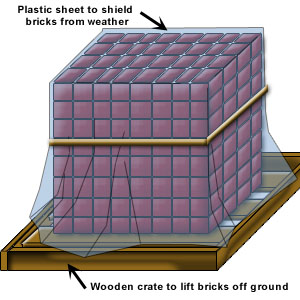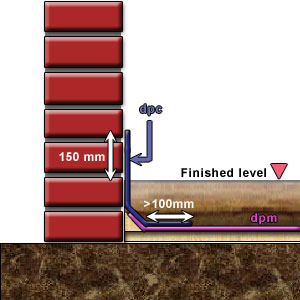Case 1
- Introduction
- Causes of Defects
- Good Practices
- Standards
- Maintenance and Diagnostics
- Remedial
- Similar Cases
- References
Good Practices
Dampness
Design
The material selection for exposed surfaces, and their regularity and surface texture should be detailed to
prevent moisture retention. Areas prone to high moisture exposure shall be made impervious with adequate waterproofing systems. Also such surfaces should be without impediments (e.g. built-in cabinet, fixed equipment/services) to ensure access for inspection and to ensure ease of cleaning. Access for adequate cleaning should be provided in accordance with BS 8221- 1, SS 509-1 or equivalent. Ventilate to prevent moisture retention on floor/wall/ceiling. For natural ventilation, opening > 5% of floor area. For mechanical ventilation, air exchange rate > 20 air changes per hour, in accordance
with “CP on Environmental Health”.
Construction
Exterior surfaces of porous building material (e.g., cellulose, brick, stone, cement rendering) can develop biological growth. Avoid such growth as much as possible with treatments of anti-algae/anti-fungus solutions and allow to dry before painting/repainting (SS 652: B.5.2.1). Improve ventilation and remove sources of dampness to dry out the substrates as thoroughly as possible during painting works in
accordance with BS 6150, SS 542 or equivalent. Ensure access ducts are connected to the mechanical
ventilation system. The exhaust system shall dispel the air directly outdoors.
Brick
Design
Design and plan well. Attention must be paid to waterproofing the brickwall. Important considerations to place on:
- Design recommendations
- wall types,
- workmanship characteristics,
- detailing, flashing,
- drips and weep holes
Methods of reducing rain loads through building design [2]:

- adequate copings on wall
- more efficient weepholes or other water drainage devices where there is a risk of water entering

- generous roof overhangs
- devices to keep water off the facade, such as window sill and roof gutters
Material
- Selection of bricks should meet the requirements of relevant standards.
- All bricks should be accompanied by the manufacturer’s certificate.
Construction
- Workmanship characterized by the complete filling of all mortar joints intended to receive mortar is desirable, as is the need to keep all cavities clean and free of mortar droppings.
- Attention to both of these items is of primary importance in preventing moisture penetration to the interior of masonry.
- Protection
- Partially completed masonry walls exposed to rain and other elements during construction may become saturated with water and can require weeks, or even months (depending on climatic conditions), after the completion of the building for the masonry to dry. This prolonged saturation may cause many “slightly” soluble salts, as well as the highly soluble salts, to go into solution. Such conditions may also contribute to the contamination of the masonry with soluble salts from elsewhere in the construction (concrete, plaster, trim, etc.).
- During construction, all walls should be kept dry by covering with a strong, waterproof membrane at the end of each workday or shutdown period. These are used in conjunction with plastic sheets or water-repellent tarpaulin material and offer excellent protection for extended periods of time.
Quality control
Conduct water test to the external full height facing brick walls to test the watertightness of external wall construction [3].
Storage

Masonry units should be stored off the ground to avoid contamination by dirt and ground water which may contain soluble salts.
Mortar
Design
| Basic composition | Cement: lime: sand with air-entrainment | Cement:sand with air entrainment | Cement:Lime:sand | ||
| Binders | Ordinary Portland cement or sulphate-resisting Portland cement | Masonry cement with high lime content (1:1:OPC:lime) | Masonry cement with other than high lime content | Ordinary Portland cement or sulphate-resisting Portland cement | |
| Designation | |||||
| (i)(ii)(iii)(iv) | 1: 1/2: 4/1/2 +Air1: 1: 5/1/2 +Air | 1: 31: 4/1/2 | 1: 2/1/2-3/1/21: 4-5!: 5/1/2-6/1/2 | 1: 3-4 + Air1: 5-6 + Air1: 7-8 + Air | 1: 0-1/4:31:1/2: 4-4/1/21:1: 5-61: 2: 8-9 |
Table 1: Mortar mixes and designations [4]
Material
- Use prepacked mortar for consistency
- It should be noted that the principal contribution to lime leaching in mortars is the high alkali content of the portland cement. Cements high in alkaline content are more prone to produce efflorescence than cements of lower alkali content.
- Other ingredients for mortar, i.e., lime, sand and water, should also be selected with care, although their contribution to efflorescence may be less frequent.
- Mortar types and proportions should be selected on the bases of structural and exposure requirements for the particular project.
Construction
- Mechanical mixing of prepacked mortar is advisable. Mixing time should be approximately 10 minutes to achieve good workability [3] .
- Fill all mortar joints solidly
- Clean all excess mortar from mortar joints.
Storage
Cementitious Materials
Cementitious materials for mortar should be stored off the ground and either inside or under cover.
Sand
Sand for mortar should also be stored off the ground to prevent contamination from dirt, plant life, organic materials and ground water, any of which may be a contributor to efflorescence. In addition, it is advisable to store sand and other aggregates under a protective membrane cover, if possible.
Construction
- During construction, ensure that most if not all water used in mortar joints has dried out before application of damp-proof course (DPC) or damp-proof membrane (DPM).
- Lay the damp proof course weighing 3.3 kg m2 to break joint on a layer of cement and sand mortar laid immediately at a level 150mm to 220mm above the ground level in brickwalls [3].
- Bed all DPCs on fresh mortar
Damp proof course
Design
DPC should be designed in conjunction with flashings and other waterproofing systems to ensure a continuous barrier.


The DPC should be laid 150mm above the finished level and also placed vertically to overlap the DPM a minimum of 100mm (Figure 4a and b).
This is so that no moisture is allowed to pass between the wall and the floor.
Lowering the groundwater level near the wall by providing site drainage or subsoil drainage; this would reduce the amount of ground water reaching the wall. Insertion of porous tubes into the outer surface of the wall; this would increase evaporation from the wall [6].
Construction
During construction, ensure that most if not all water used in mortar joints has dried out before application of damp-proof course (DPC) or damp-proof membrane (DPM).
Lay the damp proof course weighing 3.3 kg m2 to break joint on a layer of cement and sand mortar laid immediately at a level 150mm to 220mm above the ground level in brickwalls [4].
Bed all DPCs on fresh mortar.
Water repellent and surface coating system

Clear water repellents are most effective at reducing the amount of water absorbed by the brick masonry [5-7].
Surface preparation is important. The surface on which the coating is to be applied has to be:
- cleaned by grinding, chemical etching or blasting.
- dried by allowing the wall to cure for a few days before the coating is applied. During rainy periods, the walls should be protected with a plastic covering so that the drying is not interrupted.
Other surface protection systems include [8]:
- Impregnation systems:
- Prevent penetration of water and solutions into concrete without hindering the escape of internal moisture from concrete
- Materials used:
- silicon organic solutions
- resins
- oils
- Sealers
- Heavy barrier against penetrating solutions but may hinder the escape of internal moisture
- Materials used:
- epoxy resins (EP)
- polyurethane resins (PU)
- unsaturated polyester resins (UP)
- Coatings
- compared to sealers, they provide additional protection against mechanical influence.
- increased resistance to diffusion of internal moisture
- Materials used:
- plastic modified cement systems and resins
Weathering paints may be used to coat bricks to improve aesthetics [9].